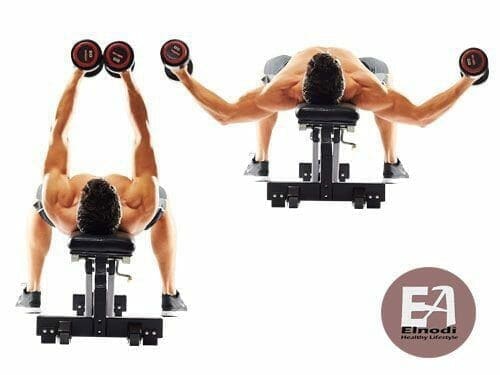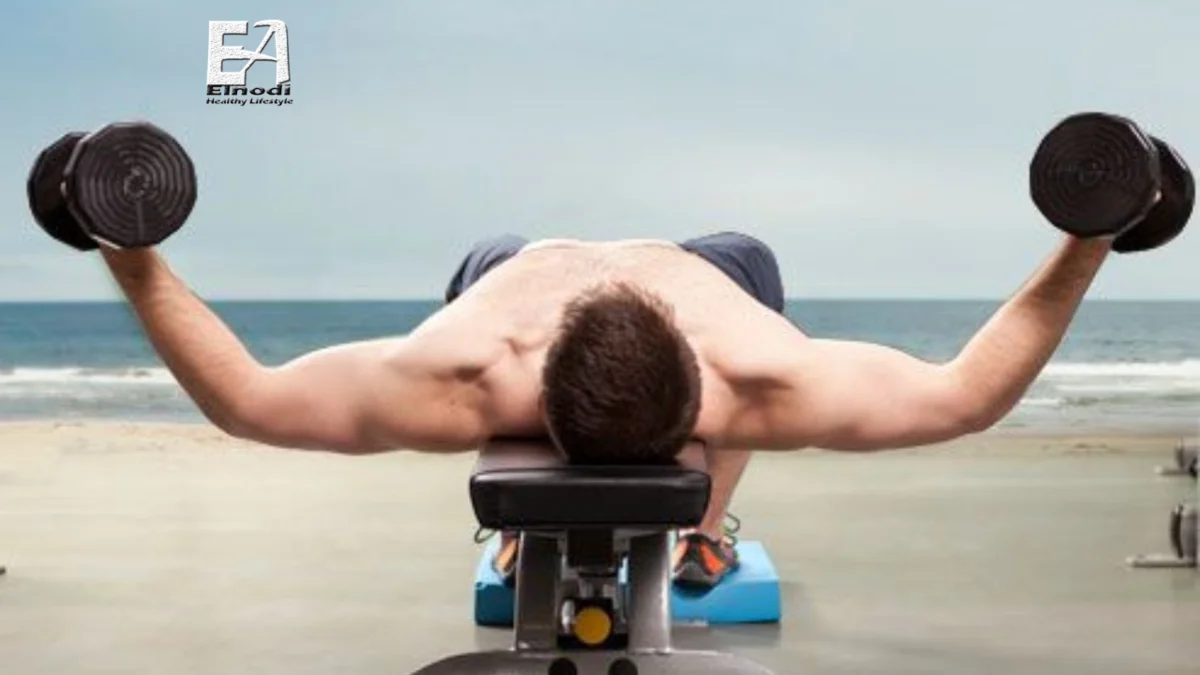Jump into the world of chest dumbbell fly exercises and see how much stronger you can get in no time! Plus, the benefits of the pec fly, muscles worked, and more.
Do you want to build strength and muscle? Fly exercises are an excellent way to do just that. In this article, we will discuss the best chest dumbbell fly exercises for strength and conditioning.
Fly exercises are perfect for increasing strength and muscle mass in the chest. They are a fast, explosive movement that can be used to target the quads, hamstrings, calves, and rotator cuff muscles. Fly exercises also have the added benefit of improving balance and coordination.
If you want to build strength and muscle in the chest with Fly exercises, following these guidelines is essential.
What is a chest dumbbell fly?
The dumbbell fly employs a chest fly movement pattern to isolate the muscles of the chest, allowing them to grow and become stronger.
The dumbbell fly is frequently regarded as a classic bodybuilding action because the exercise’s goal is to isolate the chest for aesthetic purposes. The movement itself can be used to assist build a stronger bench press, although it isn’t usually thought of in terms of better performance.
As a result, this technique is ideally suited for classic chest workouts in bodybuilding splits.
What muscles does chest dumbbell fly work?

The dumbbell chest fly works the following muscles:
- chest
- shoulders
- triceps
Other benefits include the following.
Chest opener
The dumbbell chest fly can aid in the opening of your chest muscles. Chest openers may help relieve upper back pain, increase range of motion, and lessen upper body tension.
If you’re practicing dumbbell chest flies to open up your chest muscles, try using smaller weights or maybe none at all. This can assist you in getting the entire range of motion out of the maneuver without overextending. Extending yourself too far may result in damage.
Scapular retraction
Scapular retraction exercises may help you improve your posture and increase shoulder strength.
A few chest dumbbell flies each week may help loosen up the chest and shoulder region and aid in shoulder retraction.
chest dumbbell fly Benefits
Maximizes Chest Growth
According to the Journal of Sports Medicine, people who want to build serious chest strength — whether for a powerlifting competition or a physically demanding job — should prioritize the barbell chest press, an exercise that greatly activates the pectoralis major (the largest chest muscle that lies beneath the breast tissue), the anterior deltoid (the front head of your shoulder muscle), and the triceps brachii (the muscle on the backside of your upper arm).
However, according to Wang, the dumbbell chest fly can play a vital part in helping you reach your chest strength target. “The purpose of a chest fly is to get chest adduction, which you can’t really get from standard pressing motions,”,” she clarifies. “Think of the chest fly as accessory work if you want to maximize chest growth,” Wang says.
In other words, the chest fly supplements the bench press by strengthening the smaller, supporting muscles (such as the biceps) and allowing you to push beyond plateaus during the latter exercise.
Improves Posture
While it’s very crucial to develop your back muscles to maintain good posture, concentrating on your chest can also assist you avoid slouching. “The fly is great because it’s a nice chest opener and teaches scapular retraction,” explains Joey Thurman, C.P.T., C.S.C.S., a fitness and nutrition expert and author of 365 Health and Fitness Hacks That Could Save Your Life. ICYDK, scapular retraction is the capacity to press the shoulder blades together, which is critical for countering poor posture caused by sitting bent over a desk or cell phone all day.
The Best Way to Correct Posture, According to Experts
Helps You Master Push-Ups
If you want to be able to accomplish 10 push-ups in a row with perfect technique — or even a handful without any changes — the chest fly can help. According to research, push-ups primarily engage your pectoralis major and anterior deltoid. Because the chest fly helps build strength in those same muscle areas, doing it on a regular basis can lead to higher-quality push-ups, according to Mariotti.
chest dumbbell fly Instructions

- Using a neutral grip (palms facing in), pick up the dumbbells from the floor. Sit on the bench with the ends of the dumbbells in your hip crease.
- Lay back and bring the weights close to your chest to get into position. Take a deep breath and then press the dumbbells to lockout at the top once you’re in position.
- Retract your shoulder blades slightly, unlock your elbows, and slowly descend the dumbbells laterally while maintaining the elbow angle.
- Reverse the movement by squeezing your pecs together and bringing the dumbbells back to their starting position once they reach chest level.
- Begin the next repeat without allowing the dumbbells to touch, and continue until the set is done.
chest dumbbell fly Tips
- Assume you’re attempting to do the exercise while hugging a tree.
- Squeezing the dumbbell handles too tightly might overrecruit the forearms and biceps, limiting activation of the pecs.
- To sustain consistent tension on the intended muscle groups, avoid contacting or smashing the dumbbells together at the peak of each repetition.
- Always maintain your elbows slightly bent and never decrease the weight to the point where you feel pain or pressure at the front of your shoulder joint.
- If you’re experiencing pain within the shoulder joint (particularly in the front), keep your shoulder blades slightly retracted and the shoulder girdle “packed.”
- Keep your feet flat on the floor and concentrate entirely on maintaining your elbows bent and your pecs activated.
- Maintain some tightness in your abs and avoid allowing your lower back to arch excessively.
Progression
Try to raise the weight of the dumbbells you use each week or every other week as you advance with the dumbbell chest fly workout. You can attempt adding two to three pounds per week.
Alternatively, for added difficulty, try a dumbbell chest fly on an exercise ball. This is more difficult because you’ll need to use your core to keep your body stable throughout the maneuver.
You may eventually want to progress to using a cable pull machine or executing bench presses at the gym.
If possible, have a skilled personal trainer spot you and show you how to do these exercises effectively. Using proper form will help you get the most out of the action and may also help you avoid injury.
Common chest dumbbell fly Mistakes
One of the most common form flaws Wang finds in dumbbell chest flys is allowing the scapula (called shoulder blades) to slide forward at the apex of the exercise. “It almost looks like their upper back is rounded,” Wang observes. “When you do that, it releases tension at the top, and then the pectoral fibers don’t get the desired contraction,” she explains. She recommends keeping your shoulder blades retracted and flat on the floor as you pull the dumbbells back toward your midline to make the exercise as effective as possible.
If you’re doing the move on a bench, Wang warns against dropping the dumbbells too close to the ground at your sides, especially if you’re using large weights. She notes that doing so increases the danger of a shoulder injury, especially if you lack proper shoulder mobility. “If you want to eliminate that possibility, I would just perform them on the floor,” Wang explains. “That way, the floor will limit the range of motion.” Remember to keep your wrists neutral no matter where you conduct your reps, as the pressure of the weights may create irritation if the joint is flexed, adds Mariotti.
Safety Tips
If you have a back, shoulder, or arm injury, see your doctor before practicing this maneuver. Your doctor may advise you to modify or avoid this move.
If you’re having problems doing the motion correctly, try a lesser weight. You can also try the maneuver without the weights to become acclimated to the action. Once you’ve mastered the exercises, gradually increase the weights.
Summary
If you want to strengthen your chest, shoulder, and arm muscles, the dumbbell chest fly may be a useful exercise for you. If you’re a novice, start with a light set of dumbbells and gradually increase the amount of weight each week as you gain strength.
For optimal results, combine chest flies with other chest exercises such as pushups, chest presses, planks, and seated decline cable presses. If you’re injured or in pain, stay away from chest flies. Before beginning a new workout plan, always consult with your doctor.
FAQ
are dumbbell flies good for the chest?
Is dumbbell chest fly effectively?
Indeed, workouts that strain your muscles the most when fully extended, such as the bottom of a dumbbell fly, appear to be the most effective for muscular growth. So they’re still a viable alternative, especially if you only have dumbbells at your disposal.





